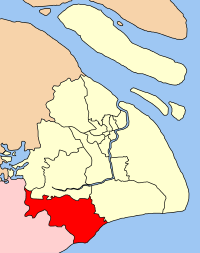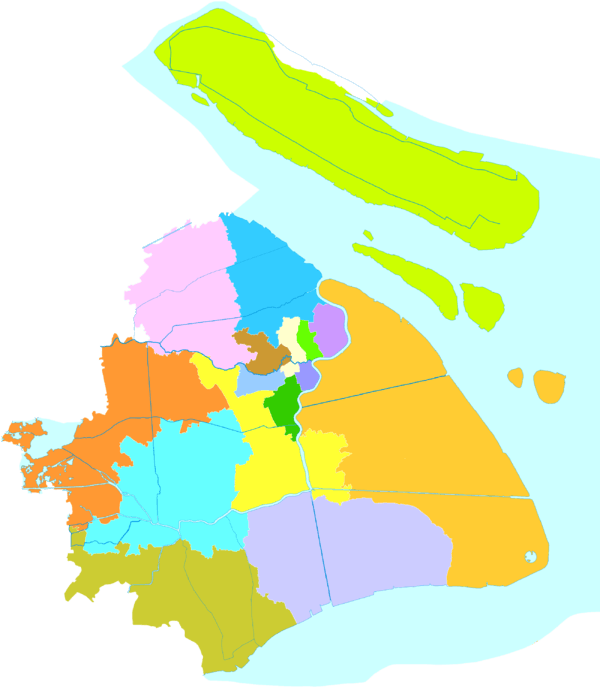Jinshan District
Jinshan District, is a suburban district of southwestern Shanghai, neighboring Zhejiang province and Hangzhou Bay. It has a land area of 586.14 square kilometers (226.31 sq mi) and a population of 732,500 as of the 2010 Chinese census.[1] Jinshan District, located in the southwest of Shanghai, is one of the biggest districts of the city. Local political administration is divided into nine towns and one subdistrict. About 6.2 kilometers (3.9 mi) off the coast of Jinshan, there are three islands named Da Jinshan ("Big Gold Mountain"), Xiao Jinshan ("Little Gold Mountain"), and Fushan ("Floating Mountain"). At 103 meters (338 ft) above sea level, the peak of Dajinshan Island is the highest point within the Shanghai municipality. There are several beaches along the 23.3-kilometer (14.5 mi) shoreline, which are popular tourism destinations.
Jinshan 金山区 Kinshan | |
|---|---|
Fengjing Ancient Town | |

| |
 Jinshan in Shanghai | |
| Country | People's Republic of China |
| Municipality | Shanghai |
| Time zone | UTC+8 (China Standard) |
| Jinshan District | |||||||||||
|---|---|---|---|---|---|---|---|---|---|---|---|
| Traditional Chinese | 金山區 | ||||||||||
| Simplified Chinese | 金山区 | ||||||||||
| Postal | Kinshan | ||||||||||
| Literal meaning | Gold Mountain District | ||||||||||
| |||||||||||
Elderly Jinshan residents speak a distinct dialect of known as Jinshanese, with different subdialects around the district. Generally speaking, it is unintelligible to Shanghainese from the central districts as it has its roots in the dialects of northern Zhejiang province(to which Jinshan district belonged in the past) although their dialect can be understood by the Jinshanese.
As the city of Shanghai has grown, Jinshan has experienced rapid changes, evolving from a relatively rural area to a more suburban environment. With completion of the high-speed highway in 2008, a new bus line was opened between Shanghai and Jinshan. This Shimei Line (t 石梅線, s 石梅线) travels between the bus station in Jinshan and another beside the Jinjiang Amusement Park subway station on Line 1 of the Shanghai subway. Travel time is about an hour, depending on traffic and time of day, and costs 10 RMB each way.
Since 2012, the Shanghai metro system also offers connections to Jinshan. This service, the Jinshan Railway, connects Jinshanwei railway station to Shanghai South railway station in downtown Shanghai in about 30 minutes.
The district is home to the Donglin Temple, a Buddhist temple dedicated to Guanyin, the bodhisattva of compassion. Jinshan peasant painting, which originated in the town of Fengjing, has become a nationally and internationally exhibited form of folk art.[2]
Economy
Jinshan District is home to the headquarters of Shanghai Petrochemical Company Ltd and Jinshan Industrial Park.[3]
Tourist attractions
Jinshanwei town is home to Jinshan City Beach, one of the few beaches within the city boundaries of Shanghai.[4] Jinshanwei is also the site of the historic Jinshanzui Fishing Village.[5]
Other attractions around Jinshan are the ancient Town of Fengjing and Donglin Temple.[6]
Subdistrict and towns
Jinshan District has one subdistrict, nine towns and one special township-level division.
| Name[7] | Chinese (S) | Hanyu Pinyin | Shanghainese Romanization | Population (2010)[8] | Area (km2) |
|---|---|---|---|---|---|
| Shihua Subdistrict | 石化街道 | Shíhuà Jiēdào | zaq hau ka do | 87,901 | 19.13 |
| Caojing town | 漕泾镇 | Cáojīng Zhèn | dzo cin tzen | 40,722 | 44.92 |
| Fengjing town | 枫泾镇 | Fēngjīng Zhèn | fon cin tzen | 82,477 | 91.67 |
| Jinshanwei town | 金山卫镇 | Jīnshānwèi Zhèn | cin se we tzen | 70,819 | 54.93 |
| Langxia town | 廊下镇 | Lángxià Zhèn | laon rau tzen | 33,658 | 46.56 |
| Lüxiang town | 吕巷镇 | Lǚxiàng Zhèn | liu raon tzen | 52,808 | 59.74 |
| Shanyang town | 山阳镇 | Shānyáng Zhèn | se yan tzen | 84,640 | 42.12 |
| Tinglin town | 亭林镇 | Tínglín Zhèn | din lin tzen | 93,758 | 79.12 |
| Zhangyan town | 张堰镇 | Zhāngyàn Zhèn | tzan i tzen | 37,057 | 35.15 |
| Zhujing town | 朱泾镇 | Zhūjīng Zhèn | tzyu zyu cin tzen | 120,084 | 75.67 |
| Jinshan Industry Zone | 金山工业区 | Jīnshān Gōngyèqū | cin se kon gniq chiu | 28,514 | 58.00 |
Notable residents
- Qian Zhijun - A Chinese actor and entertainer who first gained fame as part of the "Little Fatty" internet meme[9]
Transportation
Commuter rail
Jinshan is currently served by two suburban lines operated by China Railway:
References
- 1.
- Huancheng Guo, Guozhu Ren, Mingwei Lü (2007). Countryside of China. Beijing: China Intercontinental Press. ISBN 978-7-5085-1096-5.CS1 maint: uses authors parameter (link)
- "Contact Info." Shanghai Petrochemical. Retrieved on May 18, 2011. "Address: 48 Jinyi Road, Jinshan District, Shanghai, PRC"
- "Jinshan City Beach".
- "Jinshanzui Fishing Village".
- "Jinshan Shanghai". www.shanghaitourmap.com. Retrieved 2015-10-19.
- 金山区-行政区划网 www.xzqh.org (in Chinese). XZQH. Retrieved 2012-05-24.
- Census Office of the State Council of the People's Republic of China; Population and Employment Statistics Division of the National Bureau of Statistics of the People's Republic of China (2012). 中国2010人口普查分乡、镇、街道资料 (1 ed.). Beijing: China Statistics Print. ISBN 978-7-5037-6660-2.
- "The new cultural revolution: How Little Fatty made it big." The Independent. Thursday November 16, 2006. Retrieved on May 18, 2011.
Further reading
| Wikimedia Commons has media related to Jinshan District. |
- "Jinshan District". Encyclopedia of Shanghai. Shanghai Municipal Government. 2010. Archived from the original on 2013-03-02.

